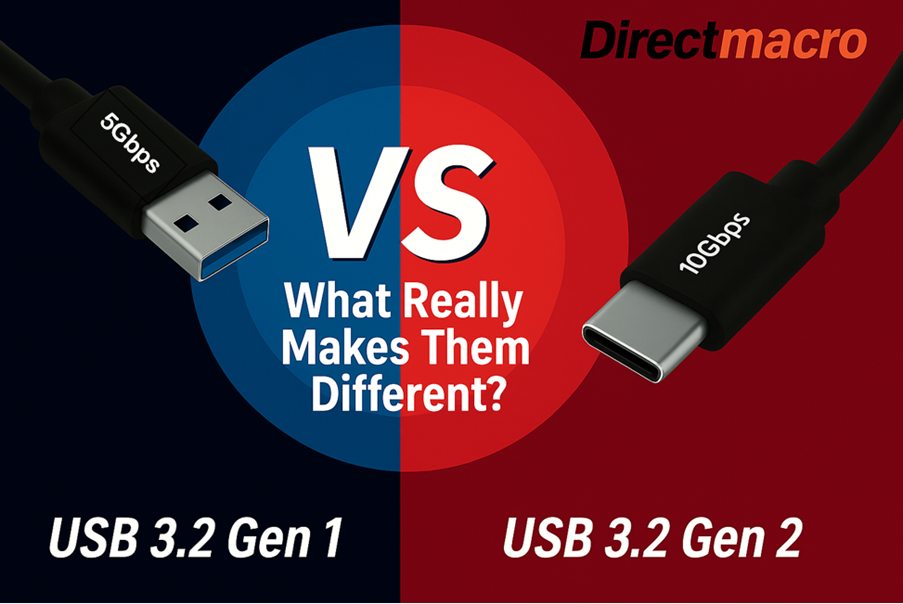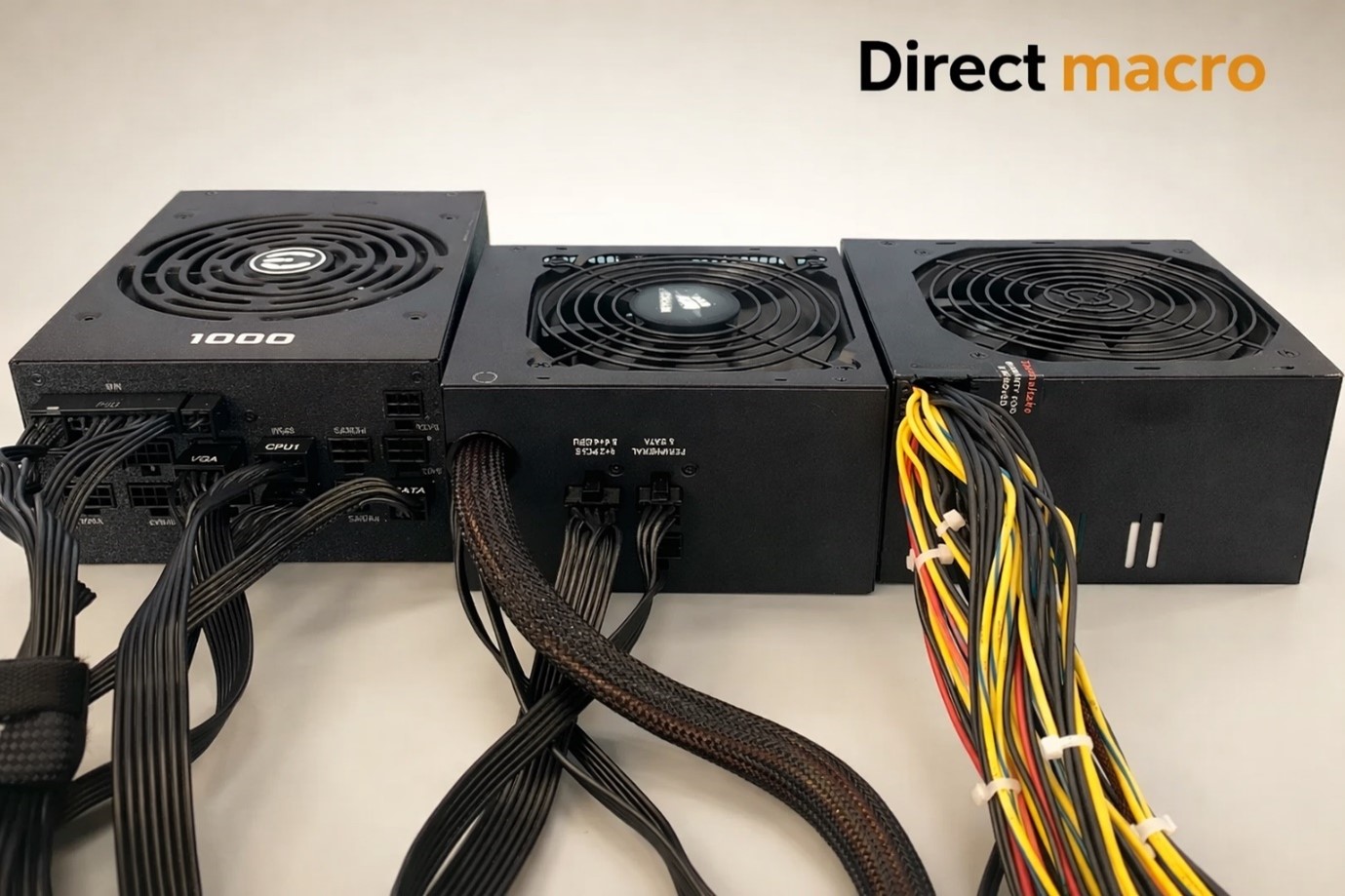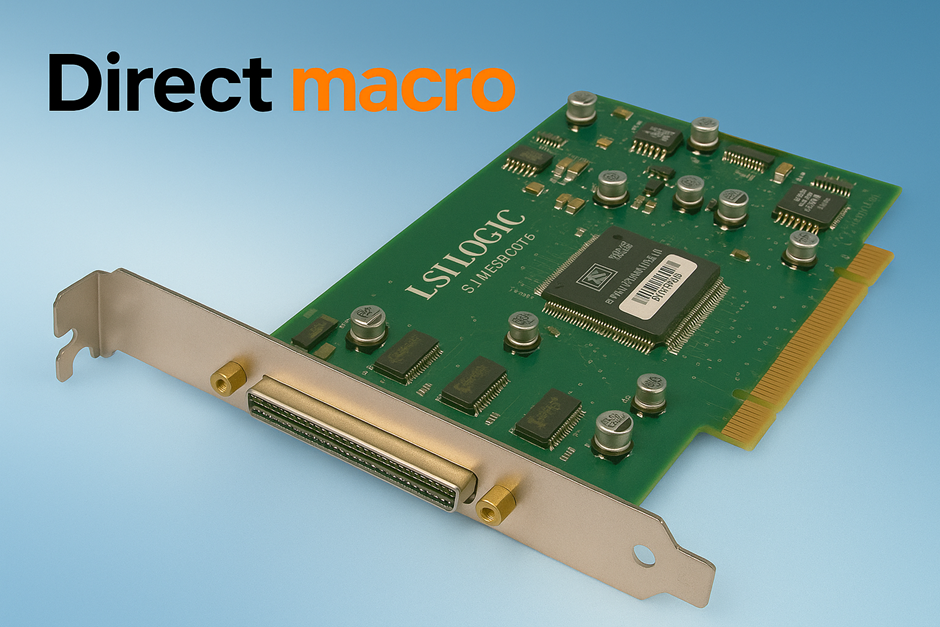USB 3.2 Gen 1 vs. Gen 2: What Really Makes Them Different?
Introduction: Decoding the USB Naming Mess
The Universal Serial Bus (USB) is probably the most used connector in modern computers. It charges our phones, connects our peripherals, and transfers trillions of bytes of data each day. Navigating the various standards, such as USB 3.2 Gen 1 vs Gen 2, USB 3.1, USB4, can feel like trying to understand an archaic, poorly translated novel. The USB Implementers Forum (USB-IF) has, over the years, built a complicated, retroactive renaming mechanism that frequently leaves customers and even tech professionals perplexed.
The current issue stems from the distinction between USB 3.2 Gen 1 vs Gen 2. While they share the USB 3.2 designation, their performance capabilities differ vastly. One provides a minor speed gain over the older USB 3.0, while the other doubles it, dramatically altering how quickly you can transmit huge files. This blog will cut through the jargon and clearly define the technical and practical differences between these two standards, allowing you to identify the required ones.
The Evolution of USB: From Gen 3.0 to Gen 3.2
To understand the present, we must examine the past. In 2008, the USB 3.0 specification included super speed USB, which has a potential maximum speed of 5 gigabits per second (Gbps). There was a significant increase of over 480 megabits per second (Mbps) in USB 2.0.
The first big step in the progression occurred with USB 3.1. Its standard introduced two main tiers:
- USB 3.1 Gen 1: It was essentially a rebadge of the current USB 3.0 technology, with the same 5 Gbps speed.
- USB 3.1 Gen 2: This version included the much-anticipated SuperSpeed+ USB feature, quadrupling potential speed to 10 Gbps.
Then came the USB 3.2 standard, where the current complexity comes from. Instead of retiring the existing names, the USB-IF merged them under the new umbrella and renamed everything:
- USB 3.1 Gen 1 was renamed USB 3.2 Gen 1 (with the same 5 Gbps speed).
- USB 3.1 Gen 2 was renamed USB 3.2 Gen 2 (with the same 10 Gbps speed).
The main novelty of USB 3.2, however, was the introduction of USB 3.2 Gen 2×2, which uses two lanes of 10 Gbps for a total theoretical speed of 20 Gbps. This 20 Gbps standard is an entirely different level of performance, and it typically requires USB-C cords.
Core Differences: USB 3.2 Gen 1 vs Gen 2
The most significant difference between USB 3.2 Gen 1 and USB 3.2 Gen 2 is speed, but the technical foundations that enable this speed are equally crucial.
-
Data Transfer Speed: The Fundamental Split
Data transmission speed is the most critical distinction between USB 3.2 Gen 1 and USB 3.2 Gen 2.
- USB 3.2 Gen 1 Speeds: Its standard has a maximum theoretical speed of 5 Gbps (gigabits per second). It is known as SuperSpeed USB 5 Gbps. It corresponds to approximately 625 megabytes per second.
- USB 3.2 Gen 2 Speeds: It’s standard works at a maximum theoretical speed of 10 Gbps, which is exactly double that of USB 3.2 Gen 1. It is known as SuperSpeed USB 10 Gbps. It corresponds to about 1,250 MB/s.
In practical terms, this doubling of USB 3.2 speed implies that transferring a large file, such as a 50GB 4K video, will take half the time on a Gen 2 connection compared to a Gen 1 connection, as long as your storage device can manage those rates.
-
Technical Specifications and Signalling
The speed discrepancy is due to a change in electrical signalling technology. Both standards use the identical fundamental differential signalling pairs for data transfer. Still, Gen 2 uses a more complex encoding strategy that allows for faster data transfer over the same physical wires. That’s why, even though the ports may appear identical, a device connected via USB 3.2 Gen 2 can achieve twice the throughput of a device connected via USB 3.2 Gen 1.
-
Cable Compatibility and Types
The cable and port compatibility and types also impact on speed, performance of data transfer:
- USB-A and USB-B: USB 3.2 Gen 1 and USB 3.2 Gen 2 can use the classic rectangular USB-A port. Even with the older A-style connector, a USB 3.2 Gen 2 connection requires particular cable wiring to handle the 10 Gbps speed.
- USB-C: The newer, reversible USB-C connector is typically needed for higher-end standards such as 20 Gbps USB 3.2 Gen 2×2. A single USB-C connection can support USB 3.2 Gen 1 (5 Gbps) and USB 3.2 Gen 2 (10 Gbps) speeds. If you wish to use USB 3.2 Gen 2’s full 10 Gbps capability, ensure the device and the cable are compatible. A Gen 2 device put into a Gen 1 port or a Gen 1 connection will immediately decrease its performance to the lower 5 Gbps USB 3.2 speed.
A Naming Nightmare: USB 3.1 vs 3.2 and the Rebranding Saga
The link between USB 3.1 and 3.2 is a major source of consumer confusion. Simply said, the term USB 3.1 has been phased out, but its characteristics continue to be supported by USB 3.2.
-
Unpacking the Jargons
To help clarify the legacy standards, here is a simplified translation:
| Legacy Name | New USB 3.2 Name | Marketing Name | Max Theoretical Speed |
| USB 3.0 / USB 3.1 Gen 1 | USB 3.2 Gen 1 | SuperSpeed USB 5 Gbps | 5 Gbps |
| USB 3.1 Gen 2 | USB 3.2 Gen 2 | SuperSpeed USB 10 Gbps | 10 Gbps |
| N/A | USB 3.2 Gen 2×2 | SuperSpeed USB 20 Gbps | 20 Gbps |
This table clearly shows that when you see USB 3.2 Gen 1, you are looking at the same 5 Gbps technology previously known as USB 3.0 or USB 3.1 Gen 1. The main takeaway is to look at the gigabits per second (Gbps) value rather than the standard designation when determining actual performance.
-
Understanding the USB 3.1 vs 3.2 Confusion
The primary source of misinformation in the USB 3.1 vs 3.2 dispute is the false assumption that upgrading from 3.1 to 3.2 resulted in an overall performance boost. In practice, a USB 3.1 Gen 2 device works identically to a USB 3.2 Gen 2 device; both are 10 Gbps. However, compared to the USB 3.2 Gen 2 standard, a USB 3.2 Gen 1 device has a slower speed. It is the most important distinction when looking for external storage or high-speed peripherals.
Performance in the Real World: What Does the Speed Difference Mean?
The main difference between USB 3.2 Gen 1 and USB 3.2 Gen 2 is the highest theoretical speed: 5 Gbps for Gen 1 and 10 Gbps for Gen 2. This performance differential results in considerably differing user experiences, particularly for data-intensive jobs.
-
File Transfers and External Drives
The performance difference is most noticeable when dealing with large file transfers to and from fast external SSDs.
| Use Case | Recommended Standard | Speed/Experience Benefit |
| Transferring large video/photo files | USB 3.2 Gen 2 | A 100 GB folder of 4K video could take about 4 minutes with a Gen 1 drive but only 2 minutes with a high-speed Gen 2 drive, taking advantage of the higher USB 3.2 speed. |
| Connecting external NVMe SSDs | USB 3.2 Gen 2 | To get the most out of a modern NVMe-based external SSD, you need the full 10 Gbps capability of USB 3.2 Gen 2. Using a Gen 1 port would bottleneck the SSD, limiting its transfer speed by half. |
| Connecting standard external HDDs | USB 3.2 Gen 1 | A mechanical hard drive maxes out around 100–150 MB/s, which is well within the 5 Gbps limit of USB 3.2 Gen 1. The extra bandwidth of Gen 2 provides no benefit here. |
| Basic Peripherals (Mouse, Keyboard, Printer) | USB 3.2 Gen 1 | Keyboards, mice, printers, and webcams require very little bandwidth. Even the older USB 3.1 speed is more than sufficient. |
-
Video and Display Connectivity
While modern display connections often employ HDMI or DisplayPort over USB-C (using technologies such as DisplayPort Alt Mode), the speed of the underlying USB standard is essential for combined functionality.
- DisplayPort Alt Mode: A USB-C connector can send a video stream. The USB standard specifies the available bandwidth for this signal and simultaneous data transfer (such as when running a hub). USB 3.2 Gen 2’s 10 Gbps provides more headroom for high-resolution, high-refresh-rate displays while transferring files faster than Gen 1’s 5 Gbps.
- VR Link Cables: Some Virtual Reality (VR) arrangements, such as connecting a headset to a PC via USB-C, require high, constant bandwidth. The double USB 3.2 speed of Gen 2 (10 Gbps) is frequently required to keep a high-resolution, low-latency video and data stream to the headset.
Future-Proofing: When to Choose USB 3.2 Gen 2
Choosing between USB 3.2 Gen 1 and USB 3.2 Gen 2 frequently comes down to considering your future requirements and budget. The significant increase in file sizes (particularly with 4K and 8K video) makes the faster Gen 2 standard a more viable option for future-proofing.
-
Use Cases for Prioritizing USB 3.2 Gen 2
- High-Speed External Storage: If you want to purchase or own an external NVMe SSD enclosure, select a USB 3.2 Gen 2 port/device for optimal performance. Using an NVMe SSD with a Gen 1 connection is like placing a powerful engine in a slow chassis; you are paying for speed you will not use.
- New Device Purchases: When purchasing a new laptop, desktop, or docking station, always read the specifications. If the price difference is negligible, choose USB 3.2 Gen 2 or higher ports (such as Gen 2×2 or USB4/Thunderbolt). It ensures you will be ready for speedier accessories in the coming years and clarifies the confusing USB 3.2 Gen 1 vs Gen 2 decision.
- Power User Hubs and Docks: A high-end dock that handles several monitors, power distribution, and various devices concurrently will benefit from the broader 10 Gbps pipe of USB 3.2 Gen 2 to avoid overall bandwidth problems.
-
Purchasing Advice
- For Budget-Conscious Users: If you connect old gadgets or mechanical hard drives, stick with the USB 3.2 Gen 1.
- For Professionals and Enthusiasts: Investing in USB 3.2 Gen 2 ports and peripherals is highly advised. It removes potential bottlenecks and assures your system can handle intensive tasks such as game streaming, external OS booting, and professional video editing.
- Check The Labelling: Be cautious before making a purchase. Manufacturers occasionally utilize ambiguous labels. Look for this technical specification: 10 Gbps is the real indicator of USB 3.2 Gen 2. If you want the fastest possible speed, avoid anything claiming 5 Gbps.
Conclusion: Making the Right Choice
The distinction between USB 3.2 Gen 1 and USB 3.2 Gen 2 comes down to a single, important factor: speed. Gen 1 provides a maximum speed of 5 Gbps, which is acceptable for most basic peripherals and older storage. Gen 2 delivers 10 Gbps, which doubles the speed, which is critical for maximizing the full potential of current, high-speed external SSDs and future-proofing your setup.
While the USB naming convention has been painfully confusing, such as USB 3.1 vs 3.2, the best advice is to ignore the Gen number and focus entirely on the gigabits per second (Gbps). If you require high-speed file transfers, always purchase a product with a 10 Gbps rating (USB 3.2 Gen 2). If you are merely connecting a mouse or a mechanical hard drive, the cheaper 5 Gbps (USB 3.2 Gen 1) would suffice.
Which standard are you seeing most frequently on the new gadgets you are contemplating purchasing?
If you are still confused about choosing between USB 3.2 gen one vs USB gen 2 then please feel free to call us at (855) 483-7810 or reach out to us through our contact us page for details and bulk order queries.
Frequently Asked Questions (FAQs)
- What is the primary difference between USB 3.2 Gen 1 and Gen 2?
The key difference is the maximum data transfer rate. USB 3.2 Gen 1 has a theoretical maximum of 5 Gbps (gigabits per second); however, USB 3.2 Gen 2 has a maximum of 10 Gbps, which is twice as fast.
- Is USB 3.2 Gen 1 the same as USB 3.0?
Yes, technically. USB 3.2 Gen 1 is essentially rebranding the original USB 3.0 specification. The three titles (USB 3.0, USB 3.1 Gen 1, and USB 3.2 Gen 1) relate to the same 5 Gbps speed tier.
- Do I need a special cable for USB 3.2 Gen 2 speed?
Yes. To get the full 10 Gbps of the USB 3.2 Gen 2 standard, you must use a 10 Gbps-rated cable or SuperSpeed USB 10 Gbps. A slower 5 Gbps cable (such as a simple USB 3.2 Gen 1 cable) will reduce connection speed, even if both the host computer and the device are Gen 2 compatible.
- What is the difference between USB 3.2 Gen 2 and Gen 2×2?
USB 3.2 Gen 2 has a single data lane that delivers 10 Gbps of USB 3.2 speed. USB 3.2 Gen 2×2 is a different, faster specification that uses two 10 Gbps data lanes (thus the “x2”) to attain a potential maximum speed of 20 Gbps. This 20 Gbps standard nearly always necessitates a USB-C connection.
Do you need advice on buying or selling hardware? Fill out the form and we will return.

Sales & Support
(855) 483-7810
We respond within 48 hours on all weekdays
Opening hours
Monday to thursday: 08.30-16.30
Friday: 08.30-15.30








